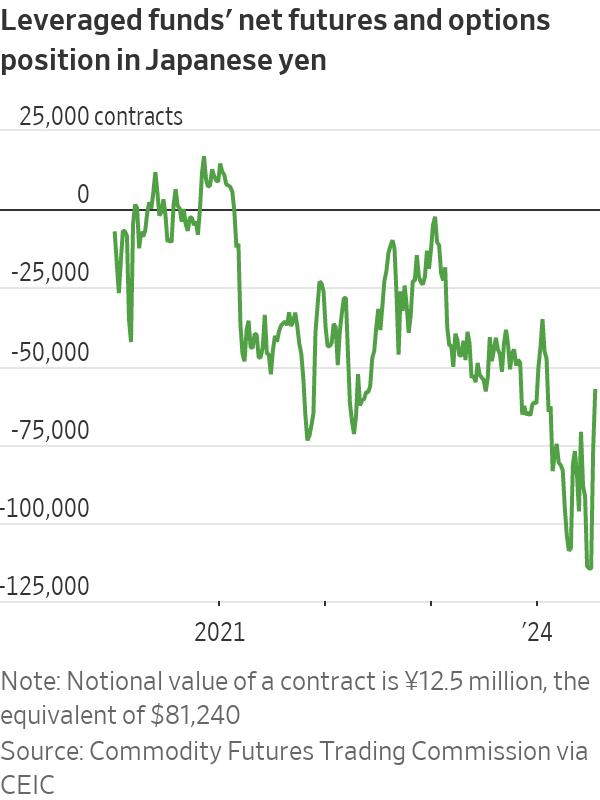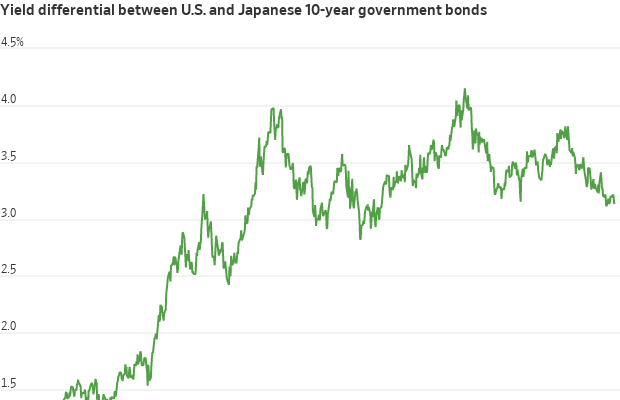Wednesday’s Other Central Bank Meeting Might Be the One to Watch
The Bank of Japan will announce an interest-rate decision on the same day as the Fed, with big consequences
All eyes will rightly be on the Federal Reserve’s interest-rate decision Wednesday. But the meeting of another central bank across the Pacific will be quite consequential too.
While Jerome Powell is pondering whether to cut rates now for the first time in more than four years or perhaps wait a couple more months, Kazuo Ueda , his counterpart in Japan, is considering whether to do the opposite . After the Bank of Japan exited its negative-interest-rate regime in March, investors are looking for more tightening to come.
The Bank of Japan raised its short-term interest rate from minus 0.1% to a range of around 0% to 0.1% in March, the first increase in 17 years. Japan’s consumer prices rose 2.8% year-on-year in June, which was off from inflation’s peak pace last year, but still well higher than Japan is accustomed to.

In a possible preview of what awaits markets if the Bank of Japan leans hawkish, the Japanese yen has risen sharply in the past few weeks, appreciating 5.2% against the dollar this month from a multi-decade low. That has likely contributed to market turmoil in other markets around the world over the past couple of weeks, including the selloff in global technology stocks, as the yen, with its low interest rates, is a favourite funding currency for traders .
Hedge funds have ramped up their short bets on the yen in the past two years but could exit their positions pretty abruptly. Leveraged funds have slashed their net short position in options and futures against the yen by half in the two weeks ended July 23, according to data from Commodity Futures Trading Commission via CEIC. That is equal to a nominal value of $4.6 billion.
But the market is divided over whether a Japanese rate increase could come as soon as this week. There is a 41% probability that the Bank of Japan could raise rates by 0.15 percentage point, inferred from pricing of overnight indexed swaps, according to Bank of America.
At the meeting this Wednesday, the Bank of Japan is also expected to outline plans to unwind its portfolio of $3.8 trillion in Japanese government bonds, likely giving a further boost to long-term rates. Japan’s 10-year government bond yields have gone up 0.44 percentage point to around 1.06% this year as investors expected higher rates.
The country was swimming against the tide over the past few years by staying put on its ultra-easy monetary policies when most major central banks were raising rates. The Bank of Japan will likely be more cautious going in the opposite direction: A sharply higher yen could be punishing to exporters , and policymakers in Japan live in perpetual fear of returning to deflation. Any surprises in the BOJ’s pace as it normalises policy could still rattle financial markets.

Over the longer term, a narrowing interest-rate differential between the U.S. and Japan could shift the pattern of investment flows. Japan had the equivalent of $4 trillion in foreign portfolio investments at the end of 2023, according to official data. That includes both companies and individuals which are scouring the globe for higher returns. Some of them might bring their money back to Japan if assets at home are generating higher yields, especially if the yen is getting stronger.
U.S. 10-year government bonds still yield around 3.1 percentage points more than Japanese ones, but that is already down from a 4.2-percentage-point gap in October. If that gap keeps narrowing, it could mean tighter financing conditions in markets around the world, which have long looked to Japan as a steady buyer.
It is rare for two of the world’s largest central banks to be at major turning points in their long-term policy settings at the same time, and rarer still for them to be moving in opposite directions. The consequences could be far-ranging and unpredictable. Investors around the world will have to get used to paying more attention to what is happening in Tokyo, not just Washington, D.C.
 Copyright 2020, Dow Jones & Company, Inc. All Rights Reserved Worldwide. LEARN MORE
Copyright 2020, Dow Jones & Company, Inc. All Rights Reserved Worldwide. LEARN MORE
A divide has opened in the tech job market between those with artificial-intelligence skills and everyone else.
A 30-metre masterpiece unveiled in Monaco brings Lamborghini’s supercar drama to the high seas, powered by 7,600 horsepower and unmistakable Italian design.
A divide has opened in the tech job market between those with artificial-intelligence skills and everyone else.
There has rarely, if ever, been so much tech talent available in the job market. Yet many tech companies say good help is hard to find.
What gives?
U.S. colleges more than doubled the number of computer-science degrees awarded from 2013 to 2022, according to federal data. Then came round after round of layoffs at Google, Meta, Amazon, and others.
The Bureau of Labor Statistics predicts businesses will employ 6% fewer computer programmers in 2034 than they did last year.
All of this should, in theory, mean there is an ample supply of eager, capable engineers ready for hire.
But in their feverish pursuit of artificial-intelligence supremacy, employers say there aren’t enough people with the most in-demand skills. The few perceived as AI savants can command multimillion-dollar pay packages. On a second tier of AI savvy, workers can rake in close to $1 million a year .
Landing a job is tough for most everyone else.
Frustrated job seekers contend businesses could expand the AI talent pipeline with a little imagination. The argument is companies should accept that relatively few people have AI-specific experience because the technology is so new. They ought to focus on identifying candidates with transferable skills and let those people learn on the job.
Often, though, companies seem to hold out for dream candidates with deep backgrounds in machine learning. Many AI-related roles go unfilled for weeks or months—or get taken off job boards only to be reposted soon after.
Playing a different game
It is difficult to define what makes an AI all-star, but I’m sorry to report that it’s probably not whatever you’re doing.
Maybe you’re learning how to work more efficiently with the aid of ChatGPT and its robotic brethren. Perhaps you’re taking one of those innumerable AI certificate courses.
You might as well be playing pickup basketball at your local YMCA in hopes of being signed by the Los Angeles Lakers. The AI minds that companies truly covet are almost as rare as professional athletes.
“We’re talking about hundreds of people in the world, at the most,” says Cristóbal Valenzuela, chief executive of Runway, which makes AI image and video tools.
He describes it like this: Picture an AI model as a machine with 1,000 dials. The goal is to train the machine to detect patterns and predict outcomes. To do this, you have to feed it reams of data and know which dials to adjust—and by how much.
The universe of people with the right touch is confined to those with uncanny intuition, genius-level smarts or the foresight (possibly luck) to go into AI many years ago, before it was all the rage.
As a venture-backed startup with about 120 employees, Runway doesn’t necessarily vie with Silicon Valley giants for the AI job market’s version of LeBron James. But when I spoke with Valenzuela recently, his company was advertising base salaries of up to $440,000 for an engineering manager and $490,000 for a director of machine learning.
A job listing like one of these might attract 2,000 applicants in a week, Valenzuela says, and there is a decent chance he won’t pick any of them. A lot of people who claim to be AI literate merely produce “workslop”—generic, low-quality material. He spends a lot of time reading academic journals and browsing GitHub portfolios, and recruiting people whose work impresses him.
In addition to an uncommon skill set, companies trying to win in the hypercompetitive AI arena are scouting for commitment bordering on fanaticism .
Daniel Park is seeking three new members for his nine-person startup. He says he will wait a year or longer if that’s what it takes to fill roles with advertised base salaries of up to $500,000.
He’s looking for “prodigies” willing to work seven days a week. Much of the team lives together in a six-bedroom house in San Francisco.
If this sounds like a lonely existence, Park’s team members may be able to solve their own problem. His company, Pickle, aims to develop personalised AI companions akin to Tony Stark’s Jarvis in “Iron Man.”
Overlooked
James Strawn wasn’t an AI early adopter, and the father of two teenagers doesn’t want to sacrifice his personal life for a job. He is beginning to wonder whether there is still a place for people like him in the tech sector.
He was laid off over the summer after 25 years at Adobe , where he was a senior software quality-assurance engineer. Strawn, 55, started as a contractor and recalls his hiring as a leap of faith by the company.
He had been an artist and graphic designer. The managers who interviewed him figured he could use that background to help make Illustrator and other Adobe software more user-friendly.
Looking for work now, he doesn’t see the same willingness by companies to take a chance on someone whose résumé isn’t a perfect match to the job description. He’s had one interview since his layoff.
“I always thought my years of experience at a high-profile company would at least be enough to get me interviews where I could explain how I could contribute,” says Strawn, who is taking foundational AI courses. “It’s just not like that.”
The trouble for people starting out in AI—whether recent grads or job switchers like Strawn—is that companies see them as a dime a dozen.
“There’s this AI arms race, and the fact of the matter is entry-level people aren’t going to help you win it,” says Matt Massucci, CEO of the tech recruiting firm Hirewell. “There’s this concept of the 10x engineer—the one engineer who can do the work of 10. That’s what companies are really leaning into and paying for.”
He adds that companies can automate some low-level engineering tasks, which frees up more money to throw at high-end talent.
It’s a dynamic that creates a few handsomely paid haves and a lot more have-nots.
ABC Bullion has launched a pioneering investment product that allows Australians to draw regular cashflow from their precious metal holdings.
BMW has unveiled the Neue Klasse in Munich, marking its biggest investment to date and a new era of electrification, digitalisation and sustainable design.























